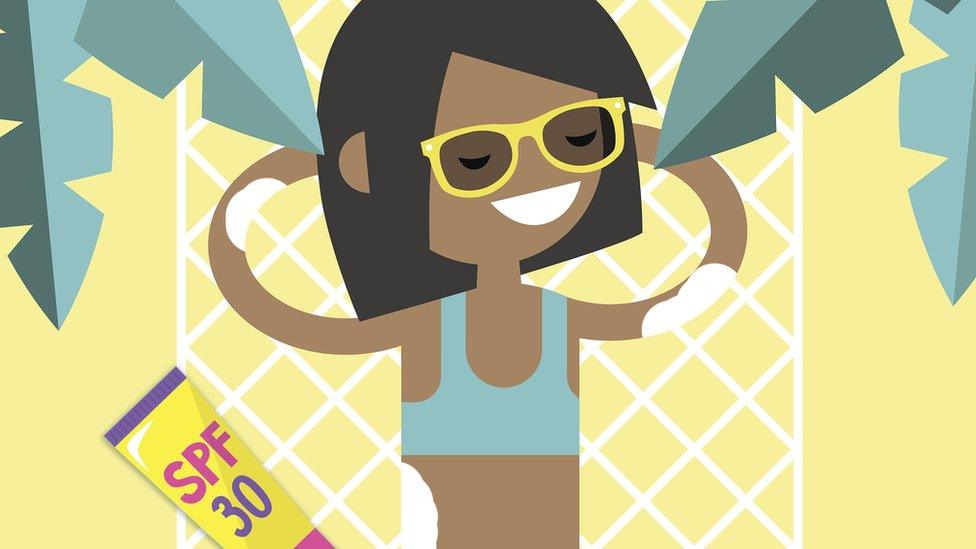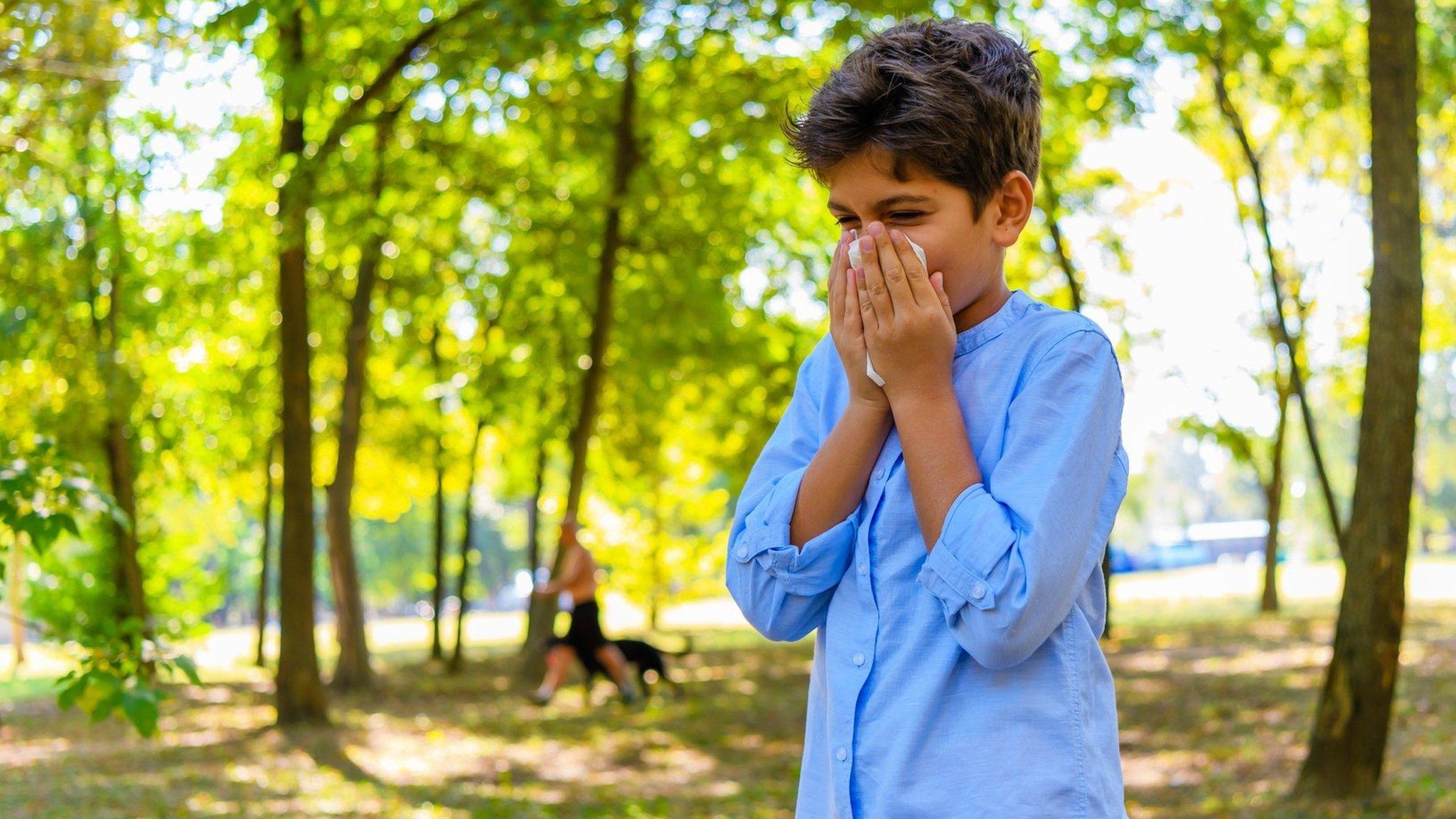Hot weather: How to stay safe in the sun
- Published
- comments
What does sun cream do, and how does it keep us safe?
After weeks of grey and gloomy weather, parts of the UK are now experiencing hotter temperatures.
Yellow heat health warnings have been issued across much of England with forecasts saying temperatures could climb to as high as 32C on Tuesday.
All areas of England, except the North East and North West, are covered by the warnings from the UK Health Security Agency (UKHSA), which are in place until Wednesday.
Many parts of the country will experience temperatures four-to-five degrees warmer than average for this time in July, the forecaster said.
The agency said the hot weather can have "significant impacts" on the health, so it's important people stay safe whilst enjoying the sunshine.
The hottest day of the year so far came on 19 July when a temperature of 31.9C was recorded at St James's Park in central London.
But are you staying safe in the sunshine? Take our quiz to find out.
Why do I need to wear sunscreen?
The sun does a lot of good for our world - without it we wouldn't be here!
It feeds our plants, it keeps us warm, it lights our way - there are a million reasons why it is good for us.
One thing it is not always good for is our skin.
Our skin is one of the most important organs (yes, it's an organ) of our body.
The sun's rays can produce a vitamin called vitamin D which is great to keep our bones healthy.
But too many rays absorbed by our skin can be dangerous, and may cause lasting damage.
People who have been exposed to too much sun can get painful burns, but they might also be at risk of becoming very unwell.
So that's why people wear sunscreen!
How much sunscreen should I wear?

Yasmin is chilling on the beach after reapplying her sunscreen every two hours
You can never wear too much sunscreen. But some research is saying that we're not wearing nearly enough!
A study by King's College London studied the damage to DNA of 16 light-skinned people who use different amounts of sunscreen.
The research showed that the group that followed the bottle's instructions were more protected.
The group who applied less than the bottle's instructions had much more UV light damage.
"Given that most people don't use sunscreens as tested by manufacturers, it's better for people to use a much higher SPF than they think is necessary," researcher Anthony Young said.
Two tablespoons is usually a good guide!
Do I need sunscreen if I have dark skin?

Nonso loves hiking and makes sure his skin is protected with sunscreen
Absolutely! Whatever colour skin you have, you definitely need sunscreen.
Darker skin tones have more of a pigment called melanin than lighter skin tones.
Some people think that having more melanin means you are protected from sunlight.
While dark skin is slightly more protected from the Sun's rays, it can burn just like light skin.
So whatever colour skin you have, make sure to slap on that sunscreen!
What kind of sunscreen should I use?

Nina loves the water - so she makes sure to put on sunscreen both before and after she jumps in the sea
This is a big, big question! But an important one to ask.
Some people get a bit overwhelmed when they see all the different letters and numbers on a bottle of sunscreen, but it's important that you know what these different things mean.
Here's a breakdown of the things you should look for on your sunscreen:
SPF
It stands for Sun Protection Factor. It tells you how long you will be protected for.
Lower numbers provide a less protection over time. Higher numbers provide more protection over time, but still need reapplying often.
If it's an overcast day, SPF 15 is often recommended.
On sunny or hot days, an SPF 30 or more is recommended, even in the UK!
Any SPF below 15 is not particularly useful and is rarely recommended.
UV protection
Ultra Violet light - this is a type of radiation that the Sun gives out that damages our skin.
There are two types to look out for - UVA and UVB.
UVA can go through the layers of skin and break down cells. This can age the skin and cause pigmentation.
UVB is the light that burns the skin - it can also cause more dangerous diseases like cancer.
Sunscreen, loose clothing, a hat and sunglasses are all great ways to protect yourself from UV rays.
Look for something called 'broad-spectrum' on your sunscreen as well.
Some sunscreens only offer UVA or UVB protection, but broad-spectrum means that you are protected from both types of radiation.
Star rating
How many stars on the bottle tells you how safe it is for UVA exposure.
Four stars is the minimum protection recommended.
For sunscreen nerds: The difference between mineral and chemical sunscreens
Chemical sunscreens have ingredients that are designed to absorb UV light and then release them before they damage your skin.
Mineral sunscreens have ingredients that form a barrier on your skin to deflect UV light. They tend to use ingredients like zinc oxide and titanium dioxide.
You will be more likely to see chemical sunscreens in supermarkets and pharmacies. They tend to be more common, as people like the way they can be easily absorbed into the skin. They need 10-15 minutes to start working.
Mineral sunscreens tend to sit on top of the skin and show up as white. They are not always as easy to use, but they are less irritating to the skin. They tend to work immediately.
How else can I stay safe in the Sun?

Kyle has read our article so he now knows what steps he must take to keep himself safe
Sunscreens offer great protection, but remember to reapply them often - every two hours - to ensure they work.
And there are lots of other things you can do to stay safe!
Make sure you have some sunglasses and a hat or headscarf to protect your eyes and the top of your head.
Long-sleeved and loose fitting clothing will help keep you cool and protect you from the Sun's rays.
Stay out of the Sun between the hours of 12pm and 3pm - this is when the it is at its hottest.
Drink lots of water and eat snacks to keep your energy up.
Find a bit of shade where you can rest if you get too hot.
- Published25 June 2024

- Published31 May 2023

- Published13 July 2013

